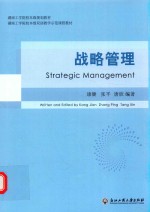图书介绍
战略管理PDF|Epub|txt|kindle电子书版本网盘下载

- 康健,张平,唐欣编著 著
- 出版社: 杭州:浙江工商大学出版社
- ISBN:9787517815334
- 出版时间:2016
- 标注页数:182页
- 文件大小:24MB
- 文件页数:191页
- 主题词:企业战略-战略管理
PDF下载
下载说明
战略管理PDF格式电子书版下载
下载的文件为RAR压缩包。需要使用解压软件进行解压得到PDF格式图书。建议使用BT下载工具Free Download Manager进行下载,简称FDM(免费,没有广告,支持多平台)。本站资源全部打包为BT种子。所以需要使用专业的BT下载软件进行下载。如BitComet qBittorrent uTorrent等BT下载工具。迅雷目前由于本站不是热门资源。不推荐使用!后期资源热门了。安装了迅雷也可以迅雷进行下载!
(文件页数 要大于 标注页数,上中下等多册电子书除外)
注意:本站所有压缩包均有解压码: 点击下载压缩包解压工具
图书目录
Chapter 1 Introduction to Strategic Management1
1.1 Strategic Competitiveness1
1.2 The Global Economy3
1.3 Vision4
1.4 Mission4
1.5 Strategic Management Process5
1.6 Developing a Strategic Vision and Mission8
1.7 Setting Objectives10
1.8 Crafting a Strategy10
1.9 Implementing and Executing a Strategy12
1.10 Approaches to Performing the Strategy-Making Task13
1.11 Strategic Management Principle14
Chapter 2 The External Environment22
2.1 The General,Industry,and Competitor Environments24
2.2 External Environmental Analysis27
2.3 Scanning29
2.4 Monitoring30
2.5 Industry Environment Analysis30
2.6 Threat of New Entrants32
2.7 Bargaining Power of Buyers33
2.8 Threat of Substitute Products34
2.9 Strategic Groups35
2.10 Ethical Considerations36
2.11 Rivalry Among Competing Sellers38
Chapter 3 The Internal Environment42
3.1 Analyzing the Internal Organization42
3.2 Creating Value42
3.3 Resources,Capabilities,and Core Competencies44
3.4 Resources45
3.5 Tangible Resources45
3.6 Intangible Resources46
3.7 Capabilities48
3.8 Core Competencies49
3.9 The Four Criteria of Sustainable Competitive Advantage49
3.10 Value Chain Analysis50
3.11 Outsourcing58
3.12 Analyzing Driving Forces59
Chapter 4 Evaluating Resources and Competitive Capabilities64
4.1 A Model of Competitive Rivalry64
4.2 Competitor Analysis65
4.3 Resource Similarity66
4.4 Competitive Rivalry66
4.5 Strategic and Tactical Actions67
4.6 Competitive Dynamics68
4.7 Slow-Cycle Markets69
4.8 Fast-Cycle Markets69
4.9 Company Situation Analysis70
4.10 Typical Company Value Chain74
4.11 How Strong the Company's Competitive Position Is76
Chapter 5 Business-Level Strategies78
5.1 Customers:Their Relationship with Business-Level Strategies78
5.2 The Purpose of Business-Level Strategies78
5.3 Types of Business-Level Strategies81
5.4 Cost Leadership Strategies82
5.5 Differentiation Strategies84
5.6 Focus Strategies87
5.7 Focused Cost Leadership Strategies88
5.8 Competitive Risks of Focus Strategies89
5.9 Integrated Cost Leadership/Differentiation Strategies89
5.10 Levels of Diversification93
5.11 Low Levels of Diversification94
5.12 Reasons for Diversification94
5.13 Value-Creating Diversification:Related Constrained and Related Linked Diversification95
Chapter 6 Functional Strategies and Strategic Choices98
6.1 Operational Relatedness:Sharing Activities98
6.2 Market Power99
6.3 Simultaneous Operational Relatedness and Corporate Relatedness100
6.4 Value-Neutral Diversification:Incentives and Resources101
6.5 Resources and Diversification101
6.6 Value-Reducing Diversification:Managerial Motives to Diversify102
6.7 The Popularity of Merger and Acquisition Strategies103
6.8 Increased Market Power104
6.9 Cost of New Product Development and Increased Speed to Market104
6.10 Learning and Developing New Capabilities105
6.11 Managers Overly Focused on Acquisitions106
6.12 Three Basic Benefits of International Strategies107
6.13 International Strategies108
6.14 International Business-Level Strategies108
6.15 Global Strategy109
6.16 Acquisitions109
6.17 Risk of Best-Cost Provider Strategies113
6.18 Merger and Acquisition Strategies115
6.19 Unbundling and Outsourcing Strategies117
6.20 Offensive Strategies and Competitive Advantage119
6.21 First-Mover Advantages119
Chapter 7 Strategy Implementation121
7.1 Implementing Internal Innovations121
7.2 Facilitating Integration and Innovation122
7.3 Innovation Through Cooperative Strategies122
7.4 Organizational Structure and Controls124
7.5 Functional Structure126
7.6 The Role of Top-Level Managers128
7.7 Top Management Teams129
7.8 Managerial Succession130
7.9 Sustaining an Effective Organizational Culture130
7.10 Establishing Balanced Organizational Controls131
7.11 Entrepreneurship and Entrepreneurial Opportunities132
7.12 Innovation133
7.13 Internal Innovation134
7.14 Incremental and Radical Innovation135
7.15 Autonomous Strategic Behavior136
7.16 Why the World Economy Is Globalizing137
7.17 Multi-domestic Strategy Maximizes Local Responsiveness138
7.18 Locating Activities to Build a Global Competitive Advantage140
7.19 What Profit Sanctuaries Are141
7.20 Advantages and Disadvantages of the Four Strategies142
7.21 New Business Model for the Internet Economy142
7.22 Internet Strategies for Traditional Businesses145
7.23 Tailoring Strategy to Fit Specific Industry Situations146
7.24 Competitive Advantage in Diversified Companies153
7.25 Sales and Marketing Fits156
7.26 What Unrelated Diversification Is157
7.27 How Broadly a Company Should Diversify158
7.28 Turnaround Strategies161
Chapter 8 Strategic Evaluation and Control162
8.1 Product Diversification as an Example of an Agency Problem162
8.2 Ownership Concentration162
8.3 Enhancing the Effectiveness of the Board of Directors163
8.4 Evaluating the Strategy of Diversified Companies164
8.5 How Corporate Strategies Form168
8.6 Building Core Competencies and Competitive Capabilities169
8.7 What the Goals of the Strategy Implementing-Executing Process Are170
8.8 Key Traits to Building Core Competencies172
8.9 Instituting Best Practices and Installing Support Systems176
8.10 What Total Quality Management Is177
8.11 What Areas Information Systems Should Address179
8.12 Guidelines for Designing an Effective Compensation System180
后记182